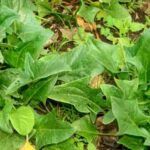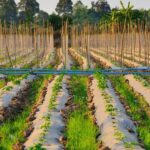Pictures of Vegetable Gardens in Containers showcases the beauty and benefits of growing vegetables in containers. These gardens offer a convenient and space-saving way to grow your own produce, even in limited areas. In this article, we will explore the various aspects of container gardening, including selecting the right containers, choosing suitable vegetables, preparing the soil, planting techniques, maintenance tips, creative container ideas, troubleshooting common issues, and ultimately embracing the joy and convenience of vegetable gardening in containers.
Container gardens provide a visually stunning display with their vibrant colors and lush foliage. Whether you have a small balcony or a spacious backyard, these gardens can be tailored to fit any space. From colorful pots on a patio to vertical garden arrangements on a wall, there are countless possibilities for creating beautiful vegetable gardens in containers.
Not only do these gardens enhance the aesthetics of your outdoor living area, but they also come with several practical benefits. Container gardening allows for greater control over soil quality and drainage than traditional ground-based methods.
Additionally, it is easier to monitor pests and protect your crops from diseases when they are grown in containers. Furthermore, apart from giving you access to fresh produce right at your doorstep, vegetable gardens in containers can also serve as a therapeutic activity that reconnects you with nature.
In the following sections of this article, we will delve deeper into container gardening methods and highlight essential tips and tricks for success. By the end of this read, you will find yourself inspired by creative design ideas and jaw-dropping pictures that showcase thriving vegetable gardens in containers. So let’s get started on this journey towards embracing the beauty and benefits of vegetable gardening.
Selecting the Right Containers
Selecting the right containers is essential for creating a successful vegetable garden in containers. The choice of containers can greatly impact the growth and health of your plants. When selecting containers, there are several factors to consider such as size, material, drainage, and aesthetics.
One important consideration when choosing containers is size. The size of the container will determine how many vegetables you can grow in it and also affect the root development of your plants. Larger plants like tomatoes and peppers will require bigger containers with ample space for their roots to grow. On the other hand, smaller vegetables like herbs or lettuce can thrive in smaller containers.
The material of the container is another factor to consider. Containers can be made from various materials such as clay, plastic, wood, or metal. Each material has its own advantages and disadvantages. Clay pots are durable but they tend to dry out quickly. Plastic pots are lightweight and retain moisture well but they may deteriorate over time under extreme temperatures. Wooden planters can provide good insulation but they may rot if not properly maintained.
Proper drainage is crucial for container gardens as it prevents waterlogged soil which can lead to root rot. Look for containers that have drainage holes at the bottom or make sure you create adequate drainage by drilling holes if necessary.
Lastly, consider the aesthetics of your container garden. Choose containers that complement your overall garden design and personal style. There are numerous options available including traditional terracotta pots, modern fiberglass planters, or even repurposed items like old buckets or vintage tea tins.
When selecting the right containers for your vegetable garden in containers, consider these factors: size, material, drainage, and aesthetics. By choosing wisely, you will provide an optimal growing environment for your plants and enhance the visual appeal of your garden.
| Factors | Considerations |
|---|---|
| Size | Choose containers that provide enough space for root development |
| Material | Consider the pros and cons of different container materials like clay, plastic, wood, or metal |
| Drainage | Ensure containers have proper drainage to prevent waterlogged soil and root rot |
| Aesthetics | Select containers that fit your garden design and personal style |
The Most Suitable Vegetables for Container Gardens
When it comes to selecting the most suitable vegetables for container gardens, there are a few key factors to consider. The size of the container, the amount of sunlight your garden receives, and the potential growth habits of the vegetable all play a role in determining which crops will thrive in your container garden.
One important consideration is the size of the container. Some larger vegetables, such as tomatoes and peppers, require more space for their roots to grow and may not do well in smaller containers. On the other hand, smaller vegetables like lettuce and herbs can be grown in smaller pots or even hanging baskets.
The amount of sunlight your container garden receives is also crucial. Most vegetables require at least six hours of direct sunlight per day to produce a good harvest. If your garden only gets limited sun exposure, consider growing shade-tolerant vegetables like spinach or kale.
It’s also important to consider the growth habit of each vegetable before planting it in a container. Some plants, like carrots or radishes, have long taproots that require deeper containers. Others, like bush beans or salad greens, have shallow root systems and can be successfully grown in shallower pots.
| Vegetable | Recommended Container Size | Sunlight Requirements |
|---|---|---|
| Tomatoes | 5 gallons or larger | Full sun (6-8 hours) |
| Lettuce | 2-4 gallons | Partial shade (4-6 hours) |
| Herbs (Basil, Rosemary, etc.) | 1-2 gallons | Full sun (6-8 hours) |
| Cucumbers | 5 gallons or larger | Full sun (6-8 hours) |
| Sweet Peppers | 3-5 gallons | Full sun (6-8 hours) |
By carefully selecting the right vegetables for your container garden based on these factors, you can ensure that your crops will thrive and provide you with a bountiful harvest. Remember to also consider your own personal preferences and culinary needs when choosing which vegetables to grow in your containers.
Preparing the Soil
Preparing the soil is a crucial step in creating a healthy and thriving container garden. Since container gardening limits the space and nutrients available to plants, it’s essential to provide them with a rich and nutritious foundation to ensure their growth. In this section, we will explore the importance of soil preparation and provide step-by-step instructions on how to create a nutrient-rich soil for your vegetable container garden.
Choosing the Right Soil
When it comes to container gardening, using the right type of soil is essential. Regular garden soil may not provide sufficient drainage or enough nutrients for your plants. Instead, opt for a high-quality potting mix that is specifically formulated for containers. These mixes are usually lightweight, well-draining, and enriched with organic matter and fertilizer. Look for potting mixes that are designed for vegetables or create your own by combining equal parts of compost, peat moss, and perlite.
Amending the Soil
To further enhance the nutrient content of your potting mix, consider amending it with organic matter. Adding compost or well-rotted manure can improve the soil structure and increase its ability to retain moisture. Mix in a ratio of one part compost or manure to three parts potting mix. Additionally, you can incorporate slow-release fertilizers into the soil mixture before planting to provide ongoing nutrition for your plants throughout their growth cycle.
Ensuring Drainage
Proper drainage is vital in container gardening as excess water can lead to root rot or other plant diseases. Before planting, make sure your containers have drainage holes at the bottom to allow any excess water to escape freely. Placing small stones or broken pottery over the drainage holes can prevent them from getting clogged with soil particles while still allowing water drainage.
By following these steps and selecting high-quality soil, you will be well on your way to creating a nutritious foundation for your container garden. Taking the time to prepare the soil properly ensures that your vegetables receive the necessary nutrients and moisture for healthy growth. In the next section, we will dive into step-by-step instructions on planting techniques for successful container gardening.
Planting Techniques
When it comes to planting a vegetable garden in containers, there are specific techniques that can help ensure success. By following these step-by-step instructions, you can create a thriving container garden that yields a bountiful harvest.
Firstly, it is essential to choose the right potting mix for your containers. Regular garden soil is not suitable for container gardening as it tends to become compacted and drains poorly. Instead, opt for a high-quality potting mix that is lightweight and well-draining. This will provide the necessary nutrients while allowing excess water to drain away, preventing root rot.
Next, consider the spacing requirements for each vegetable you intend to grow. Overcrowding can lead to poor air circulation and increased risk of disease. As a general guideline, allow 6 inches of space between small plants like herbs or lettuce, 12 inches for medium-sized plants such as peppers or tomatoes, and up to 24 inches for larger vegetables like squash or cucumbers.
When it comes to actually planting your vegetables in containers, start by filling the container with potting mix until it is about two-thirds full. Gently remove the seedlings from their nursery pots and loosen the root ball if necessary. Place the plants into the container, making sure they are centered and at the appropriate depth. Fill in any gaps with additional potting mix, firming it gently around the base of each plant.
Lastly, provide adequate water to keep your container garden hydrated. Containers tend to dry out faster than traditional gardens due to increased exposure to sun and wind. Water deeply until moisture drains from the bottom of the container whenever the top inch of soil feels dry. Avoid overwatering, as this can lead to root rot and other issues.
By following these planting techniques, you can set your vegetable container garden up for success from day one. With proper soil, spacing, and watering, your plants will thrive and provide you with a delicious harvest to enjoy.
Maintenance Tips
Maintaining a vegetable garden in containers requires attention to the watering, fertilizing, and pest control needs of your plants. Proper maintenance ensures that your plants stay healthy and productive, resulting in a thriving container garden. Here are some essential tips to help you keep your vegetable container garden in top condition.
1. Watering: One of the most critical aspects of maintaining a container garden is ensuring proper watering. Container plants tend to dry out more quickly than those in traditional gardens, so it’s important to monitor soil moisture levels regularly.
Aim for evenly moist soil, but avoid overwatering, as this can lead to root rot. A good way to check if your plants need water is by sticking your finger 1-2 inches into the soil – if it feels dry at that depth, it’s time to water.
2. Fertilizing: Since container gardens have limited space for roots to spread and obtain nutrients, regular fertilizing is crucial for healthy plant growth and productivity. Choose a slow-release organic fertilizer specially formulated for vegetables and follow the package instructions for application rates. Additionally, consider supplementing with liquid or water-soluble fertilizers every two weeks during the growing season to provide an extra boost of nutrients.
3. Pest Control: Container gardens are not immune to pests, so implementing effective pest control strategies is important for protecting your crops. Regularly inspect your plants for signs of insect damage or disease and take prompt action when necessary.
Organic pesticides or homemade remedies like neem oil or insecticidal soap can be effective against common pests such as aphids or spider mites. Additionally, companion planting can help deter pests; for example, planting marigolds alongside vegetables can repel harmful insects.
By following these maintenance tips for watering, fertilizing, and pest control in your vegetable container garden, you’ll ensure the health and productivity of your crops. Remember to adjust your maintenance routine based on individual plant needs and environmental conditions. Enjoy the process of nurturing your container garden, and soon you’ll be rewarded with a bountiful harvest of fresh vegetables from your own homegrown oasis.
Creative Container Ideas
Container gardening offers endless possibilities for creativity and design. By thinking outside the box, you can transform ordinary containers into stunning works of art that showcase your vegetable garden in a unique and eye-catching way. In this section, we will explore some creative container ideas that will inspire your imagination and help you create a one-of-a-kind vegetable garden.
One idea for creative containers is to repurpose everyday items. Look around your home or local thrift stores for items that can be transformed into planters. Old buckets, tin cans, wine barrels, and even kitchenware like colanders or teapots can add a whimsical touch to your garden. Not only will these repurposed containers add character, but they are also cost-effective and environmentally friendly.
Another option to consider is vertical gardening. If you are limited on horizontal space, vertical gardens provide a fantastic solution by utilizing the upward space available. You can use hanging baskets or wall-mounted planters to grow your vegetables vertically. This not only maximizes space but also creates an impressive focal point in your garden.
For those looking for a more contemporary design aesthetic, consider using sleek and modern containers made of materials like fiberglass or metal. These types of containers offer a clean and minimalist look that compliments modern architecture and landscaping styles. Pairing these containers with bold-colored vegetables can create a visually striking contrast.
Showcasing Success
In this section, we will highlight some inspiring pictures of vegetable gardens in containers. These images will showcase the beauty and potential of container gardening while providing readers with ideas and inspiration for their own gardens.
Vertical Gardens
One popular and visually stunning option for container gardens is the use of vertical space. Using trellises, wall-mounted planters, or tiered shelving, gardeners can maximize their growing area while adding an eye-catching element to their outdoor space. Pictures of thriving vertical vegetable gardens in containers can illustrate how different vegetables like tomatoes, cucumbers, and pole beans can be trained upwards to make the most of limited space.
Colorful Container Combos
Container gardening doesn’t have to be limited to traditional terracotta pots or plain plastic containers. Gardeners can get creative with their choice of containers and create beautiful combinations that are as aesthetically pleasing as they are productive. Pictures of vegetable gardens in containers featuring colorful ceramic pots, decorative baskets, or repurposed items like old wheelbarrows or buckets can inspire readers to think outside the box when it comes to choosing container materials.
Small-Space Solutions
For those with limited outdoor spaces such as balconies or small patios, container gardening offers a fantastic solution for growing fresh produce. Showcasing pictures of successful small-space vegetable gardens in containers demonstrates how even the tiniest spaces can yield abundant crops. These images can feature compact plants like cherry tomatoes, herbs, or salad greens thriving in well-chosen containers placed strategically in sun-soaked corners or hanging from railings.
By including these jaw-dropping pictures of thriving vegetable gardens in containers, readers will be able to see firsthand the beauty and success that is possible with this gardening technique. These visuals will provide inspiration and motivation for readers looking to start their own container gardens or improve their existing ones.
Whether it’s through vertical gardening, colorful container combos, or small-space solutions, these pictures will show that anyone can create a stunning and productive vegetable garden regardless of their available space or resources.
Troubleshooting Common Issues
Container gardening offers numerous benefits, but like any form of gardening, it can present its fair share of challenges. In this section, we will explore some common issues that gardeners may encounter when practicing vegetable gardening in containers and provide practical solutions to overcome them.
One common challenge in container gardening is inadequate drainage, which can lead to waterlogged roots and root rot. To address this issue, it is crucial to choose containers with drainage holes at the bottom. Ensure that the holes are not obstructed and allow excess water to drain freely.
Using a well-draining potting mix is also essential. Avoid using regular garden soil as it tends to be too heavy for container gardening. Instead, opt for a lightweight mix specifically formulated for container plants.
Another challenge that gardeners often face is limited space for root growth in containers. This can result in stunted or crowded plants and hinder their overall productivity. To tackle this issue, select varieties of vegetables that are known for their compact growth habit or those specifically bred for container gardens. Additionally, consider utilizing vertical space by incorporating trellises or stakes to support vining crops such as tomatoes or cucumbers.
Pest infestations can also be a recurring problem in container gardens. Common pests like aphids, caterpillars, and spider mites can wreak havoc on your vegetables if left unchecked. Regularly inspect your plants for signs of pest damage and promptly take action if necessary. There are natural remedies available such as insecticidal soaps or homemade sprays made from ingredients like neem oil or garlic that can help control pests effectively without harming the environment.
By addressing these common challenges head-on and implementing practical solutions, you can ensure the success of your vegetable garden in containers. Troubleshooting issues such as inadequate drainage, limited space for root growth, and pest infestations will help you create a thriving and productive container garden that brings joy and delicious harvests throughout the growing season.
Conclusion
In conclusion, vegetable gardening in containers offers a multitude of benefits that make it an appealing and convenient option for garden enthusiasts. From the ability to customize and adapt to limited spaces, to the convenience of maintenance and ease of accessibility, container gardening is a wonderful way to bring the joy of growing your own food into your life.
By selecting the right containers and choosing suitable vegetables, you can create a thriving container garden that not only adds beauty to your space but also provides you with fresh and nutritious produce. The step-by-step instructions provided in this article will guide you through the process of preparing the soil, planting techniques, and maintenance tips for successful container gardening.
Furthermore, with creative container ideas and repurposed items, you can transform your vegetable garden into a stunning display of both nature’s bounty and your own artistic flair. The showcase of jaw-dropping pictures shared in this article serves as inspiration for creating your own visually captivating container gardens.
In embracing vegetable gardening in containers, you are not only embracing the joy of cultivating plants but also contributing to sustainability by reducing waste and optimizing resources. So why wait? Start your own vegetable garden in containers today and experience firsthand the joy and convenience it brings to your life.

If you’re looking to get into vegetable gardening, or are just looking for some tips on how to make your current garden better, then you’ve come to the right place! My name is Ethel and I have been gardening for years. In this blog, I’m going to share with you some of my best tips on how to create a successful vegetable garden.





